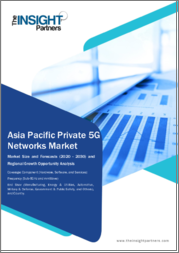
|
시장보고서
상품코드
1533132
아시아태평양의 프라이빗 5G 네트워크 시장 예측(-2030년) - 지역별 분석 : 구성요소별, 주파수별, 최종사용자별Asia Pacific Private 5G Networks Market Forecast to 2030 - Regional Analysis - by Component, Frequency, and End User |
||||||
아시아태평양의 프라이빗 5G 네트워크 시장은 2022년 4억 4,123만 달러로 평가되었습니다. 2030년에는 64억 9,698만 달러에 달할 것으로 예상되며, 2022-2030년간 연평균 40.0% 성장할 것으로 예측됩니다.
자동차 산업에서 시간 민감형 네트워킹 도입 증가로 아시아태평양의 프라이빗 5G 네트워크 시장 성장 촉진
시간에 민감한 네트워킹(TSN)은 이더넷 네트워크를 통한 예측 가능한 저지연 통신을 위한 프로토콜 세트입니다. 따라서 자율 주행 및 ADAS(첨단 운전자 보조 시스템)와 같이 실시간 통신이 필요한 용도에 사용하기에 적합합니다. 차량용 용도에서 프라이빗 5G 네트워크는 표준 공용 셀룰러 네트워크에 비해 일정한 이점이 있습니다. 더 넓은 대역폭, 더 낮은 지연, 더 높은 신뢰성을 제공할 수 있습니다. 이는 프라이빗 5G 네트워크가 특정 사용자나 조직 전용이기 때문에 공공 네트워크와 같은 혼잡 문제가 없기 때문이며, TSN과 프라이빗 5G 네트워크의 조합은 자동차 산업에 새로운 기회를 창출하고 있습니다. 예를 들어, TSN은 자율주행차의 다양한 센서, 액추에이터 및 제어 시스템 간의 실시간 통신을 가능하게 하는 데 사용할 수 있습니다. 이는 자율 주행 시스템의 안전과 신뢰성을 보장하는 데 매우 중요하며, TSN 기술이 부상하고 있습니다. 예를 들어, IEEE 표준화 협회는 자동차 산업에서 채택이 증가함에 따라 새로운 TSN 용도 프로파일을 추진하고 있습니다. 따라서 자동차 산업에서 TSN에 대한 관심이 높아지는 것은 프라이빗 5G 네트워크 시장의 성장 기회가 될 수 있습니다. 자동차 업계가 자율주행차 및 ADAS 시스템을 지속적으로 개발 및 도입함에 따라, 프라이빗 5G 네트워크에 대한 수요는 지속적으로 증가할 것으로 예상됩니다.
아태지역 프라이빗 5G 네트워크 시장 개요
아태지역은 세계에서 가장 크고 혁신적인 경제권으로, 많은 기업들이 업무 효율성과 생산성을 높이기 위해 이미 프라이빗 5G 네트워크 도입을 고려하고 있습니다. 예를 들어, 중국에서는 화웨이와 ZTE를 비롯한 많은 주요 제조업체들이 프라이빗 5G 네트워크를 통해 스마트 제조 솔루션을 도입하고 있습니다. 국내에서는 Samsung Electronics와 SK텔레콤이 차세대 5G 코어 네트워크 개발 및 시험에 성공했다고 발표했습니다. 양사는 새로운 앱의 설치, 프로비저닝, 활성화 기능을 효율적으로 강화해 새로운 5G 이용 사례를 발굴하고, 프라이빗 5G 네트워크를 통해 소비자에게 새로운 몰입형 기능을 제공하고, 기업의 5G 접근성을 향상시킬 수 있을 것으로 기대하고 있습니다. 기업들에게 5G의 접근성과 구축 용이성을 높여주는 고급 네트워크 기능을 개발하고 있습니다. 또한, 아시아태평양 정부들은 프라이빗 5G 네트워크 구축을 촉진하는 데 있어 중요한 역할을 하고 있습니다. 예를 들어, 인도 정부는 자국 내 민간 5G 생태계 개발을 지원하기 위해 여러 가지 이니셔티브를 시작했습니다. 일본 정부도 자국 내 민간 5G 네트워크 구축을 지원하기 위해 많은 자금을 배정하고 있습니다. 따라서 아시아태평양의 프라이빗 5G 네트워크 시장은 기업의 빠르고 안정적인 연결에 대한 수요 증가, 정부 지원 확대, 5G 생태계 성숙도 향상 등 여러 요인으로 인해 향후 몇 년동안 큰 성장을 보일 것으로 예상됩니다.
아태지역 프라이빗 5G 네트워크 시장 매출 및 2030년까지의 예측(금액)
아시아태평양의 프라이빗 5G 네트워크 시장 세분화
아태지역 프라이빗 5G 네트워크 시장은 구성 요소, 주파수, 최종 사용자, 국가별로 세분화됩니다. 구성 요소에 따라 아시아태평양의 프라이빗 5G 네트워크 시장은 하드웨어, 소프트웨어 및 서비스로 분류됩니다. 하드웨어 부문이 2022년 가장 큰 시장 점유율을 차지했습니다.
주파수 기준으로 아시아태평양의 프라이빗 5G 네트워크 시장은 6GHz 이하와 밀리미터파로 양분됩니다. 6GHz 이하 부문이 2022년 큰 시장 점유율을 차지했습니다.
최종 사용자별로 보면, 아시아태평양의 프라이빗 5G 네트워크 시장은 제조, 에너지 및 유틸리티, 자동차, 군사 및 방위, 정부 및 공공 안전, 기타로 분류되며, 2022년에는 제조 부문이 가장 큰 시장 점유율을 차지할 것으로 예상됩니다.
국가별로는 아시아태평양 민간 5G 네트워크 시장은 중국, 일본, 한국, 한국, 호주, 인도, 기타 아시아태평양으로 구분되며, 2022년 아시아태평양 민간 5G 네트워크 시장 점유율은 중국이 독식했습니다.
Cisco Systems Inc, Huawei Technologies Co Ltd, Nokia Corp, Telefonaktiebolaget LM Ericsson, T-Systems International GmbH, Verizon Communications Inc, Vodafone Group Plc, AT&T, Qualcomm Inc, Amazon Web Services Inc는 아시아태평양의 프라이빗 5G 네트워크 시장에서 활동하는 주요 기업입니다.
목차
제1장 서론
제2장 주요 요약
- 주요 인사이트
- 시장의 매력
제3장 조사 방법
- 조사 범위
- 2차 조사
- 1차 조사
제4장 아시아태평양의 프라이빗 5G 네트워크 시장 구도
- PEST 분석
- 생태계 분석
- 밸류체인 벤더 리스트
제5장 아시아태평양의 프라이빗 5G 네트워크 시장 : 주요 산업 역학
- 프라이빗 5G네트워크 시장 : 주요 산업 역학
- 시장 성장 촉진요인
- 시장 성장 억제요인
- 시장 기회
- 향후 동향
- 성장 촉진요인과 억제요인의 영향
제6장 프라이빗 5G네트워크 시장 : 아시아태평양 시장 분석
- 프라이빗 5G네트워크 시장 매출, 2022년-2030년
- 프라이빗 5G네트워크 시장 예측과 분석
제7장 아시아태평양의 프라이빗 5G 네트워크 시장 분석 : 컴포넌트별
- 하드웨어
- 소프트웨어
- 서비스
제8장 아시아태평양의 프라이빗 5G 네트워크 시장 분석 : 주파수별
- Sub-6 GHz
- mmWave
제9장 아시아태평양의 프라이빗 5G 네트워크 시장 분석 : 최종사용자별
- 제조
- 에너지 및 유틸리티
- 자동차
- 군 및 방위
- 정부 및 공공안전
- 기타
제10장 아시아태평양의 프라이빗 5G 네트워크 시장 : 국가별 분석
- 아시아태평양
- 중국
- 일본
- 한국
- 호주
- 인도
- 기타 아시아태평양
제11장 경쟁 구도
- 주요 기업의 히트맵 분석
제12장 업계 상황
- 시장 이니셔티브
- 제품 개발
제13장 기업 개요
- Cisco Systems Inc
- Huawei Technologies Co Ltd
- Nokia Corp
- Telefonaktiebolaget LM Ericsson
- T-Systems International GmbH.
- Verizon Communications Inc
- Vodafone Group Plc
- AT&T Inc
- Qualcomm Inc
- Amazon Web Services Inc
제14장 부록
LSH 24.09.13The Asia Pacific private 5G networks market was valued at US$ 441.23 million in 2022 and is expected to reach US$ 6,496.98 million by 2030; it is estimated to record a CAGR of 40.0% from 2022 to 2030.
Increasing Deployment of Time-Sensitive Networking in Automotive Industries Boosts Asia Pacific Private 5G Networks Market
Time-sensitive networking (TSN) is a set of protocols for predictable, low-latency communication across Ethernet networks. As a result, it is suited for use in applications requiring real-time communication, such as autonomous driving and advanced driver assistance systems (ADAS). For automotive applications, private 5G networks have certain advantages over standard public cellular networks. They can offer more bandwidth, lower latency, and more reliability. This is due to the fact that private 5G networks are dedicated to a particular user or organization and do not have the same congestion difficulties as public networks. The combination of TSN and private 5G networks is creating new opportunities for the automotive industry. For example, TSN can be used to enable real-time communication between various sensors, actuators, and control systems in an autonomous vehicle. This is crucial for ensuring the safety and reliability of autonomous driving systems. TSN technologies are emerging. For instance, the IEEE Standards Association advances new TSN application profiles as adoption increases in the automotive industry. Therefore, the growing interest in TSN in the automotive industry is an opportunity for growth in the private 5G network market. As the automotive industry continues to develop and deploy autonomous vehicles and ADAS systems, the demand for private 5G networks is expected to continue to grow.
Asia Pacific Private 5G Networks Market Overview
Asia Pacific is home to some of the world's largest and most innovative economies, and many enterprises in the region are already looking to adopt private 5G networks to improve their operational efficiency and productivity. For example, in China, a number of leading manufacturers, such as Huawei and ZTE, are using private 5G networks to implement smart manufacturing solutions. In South Korea, Samsung Electronics. Co. Ltd. and SK Telecom announced that the two companies successfully developed and trialed the next-generation 5G core network. Both companies intend to identify new 5G use cases by enhancing their ability to effectively install, provision, and activate new apps. With private 5G networks, Samsung and SKT are developing advanced network capabilities to enable the delivery of these new immersive capabilities to consumers and increase the accessibility and deployment ease of 5G for enterprises. Moreover, governments in Asia Pacific are playing an important role in promoting the deployment of private 5G networks. For example, the Indian government has launched a number of initiatives to support the development of a private 5G ecosystem in the country. The Japanese government has also allocated a significant amount of funding to support the deployment of private 5G networks in the country. Therefore, the private 5G network market in Asia Pacific is expected to witness significant growth in the coming years, driven by a number of factors, including the rising demand for high-speed and reliable connectivity from enterprises, growing government support, and the increasing maturity of the 5G ecosystem.
Asia Pacific Private 5G Networks Market Revenue and Forecast to 2030 (US$ Million)
Asia Pacific Private 5G Networks Market Segmentation
The Asia Pacific private 5G networks market is segmented based on component, frequency, end user, and country. Based on component, the Asia Pacific private 5G networks market is categorized into hardware, software, and services. The hardware segment held the largest market share in 2022.
Based on frequency, the Asia Pacific private 5G networks market is bifurcated into sub-6GHz and mmwave. The sub-6GHz segment held a larger market share in 2022.
Based on end user, the Asia Pacific private 5G networks market is categorized into manufacturing, energy and utilities, automotive, military and defense, government and public safety, and others. The manufacturing segment held the largest market share in 2022.
Based on country, the Asia Pacific private 5G networks market is segmented into China, Japan, South Korea, Australia, India, and the Rest of Asia Pacific. China dominated the Asia Pacific private 5G networks market share in 2022.
Cisco Systems Inc, Huawei Technologies Co Ltd, Nokia Corp, Telefonaktiebolaget LM Ericsson, T-Systems International GmbH, Verizon Communications Inc, Vodafone Group Plc, AT&T, Qualcomm Inc, and Amazon Web Services Inc are some of the leading companies operating in the Asia Pacific private 5G networks market.
Table Of Contents
1. Introduction
- 1.1 The Insight Partners Research Report Guidance
- 1.2 Market Segmentation
2. Executive Summary
- 2.1 Key Insights
- 2.2 Market Attractiveness
3. Research Methodology
- 3.1 Coverage
- 3.2 Secondary Research
- 3.3 Primary Research
4. Asia Pacific Private 5G Networks Market Landscape
- 4.1 Overview
- 4.2 PEST Analysis
- 4.3 Ecosystem Analysis
- 4.3.1 List of Vendors in Value Chain
5. Asia Pacific Private 5G Networks Market - By Key Industry Dynamics
- 5.1 Private 5G Networks Market - Key Industry Dynamics
- 5.2 Market Drivers
- 5.2.1 Increasing Demand for IoT
- 5.2.2 Rising Digitalization across Enterprises
- 5.3 Market Restraints
- 5.3.1 High Deployment and Maintenance Cost
- 5.3.2 Limited Coverage Area
- 5.4 Market Opportunities
- 5.4.1 Increasing Deployment of Time-Sensitive Networking in Automotive Industries
- 5.4.2 Growing adoption of Private 5G Networks in Mining Industry
- 5.5 Future Trends
- 5.5.1 Increasing use of 5G small cells
- 5.6 Impact of Drivers and Restraints:
6. Private 5G Networks Market - Asia Pacific Market Analysis
- 6.1 Private 5G Networks Market Revenue (US$ Million), 2022 - 2030
- 6.2 Private 5G Networks Market Forecast and Analysis
7. Asia Pacific Private 5G Networks Market Analysis - By Component
- 7.1 Hardware
- 7.1.1 Overview
- 7.1.2 Hardware Market, Revenue and Forecast to 2030 (US$ Million)
- 7.2 Software
- 7.2.1 Overview
- 7.2.2 Software Market, Revenue and Forecast to 2030 (US$ Million)
- 7.3 Services
- 7.3.1 Overview
- 7.3.2 Services Market, Revenue and Forecast to 2030 (US$ Million)
8. Asia Pacific Private 5G Networks Market Analysis - By Frequency
- 8.1 Sub-6 GHz
- 8.1.1 Overview
- 8.1.2 Sub-6 GHz Market Revenue and Forecast to 2030 (US$ Million)
- 8.2 mmWave
- 8.2.1 Overview
- 8.2.2 mmWave Market Revenue and Forecast to 2030 (US$ Million)
9. Asia Pacific Private 5G Networks Market Analysis - By End User
- 9.1 Manufacturing
- 9.1.1 Overview
- 9.1.2 Manufacturing Market Revenue and Forecast to 2030 (US$ Million)
- 9.2 Energy and Utilities
- 9.2.1 Overview
- 9.2.2 Energy and Utilities Market Revenue and Forecast to 2030 (US$ Million)
- 9.3 Automotive
- 9.3.1 Overview
- 9.3.2 Automotive Market Revenue and Forecast to 2030 (US$ Million)
- 9.4 Military and Defense
- 9.4.1 Overview
- 9.4.2 Military and Defense Market Revenue and Forecast to 2030 (US$ Million)
- 9.5 Government and Public Safety
- 9.5.1 Overview
- 9.5.2 Government and Public Safety Market Revenue and Forecast to 2030 (US$ Million)
- 9.6 Others
- 9.6.1 Overview
- 9.6.2 Others Market Revenue and Forecast to 2030 (US$ Million)
10. Asia Pacific Private 5G Networks Market - Country Analysis
- 10.1 Asia Pacific
- 10.1.1 Asia Pacific Private 5G Networks Market Overview
- 10.1.2 Asia Pacific Private 5G Networks Market Revenue and Forecasts and Analysis - By Country
- 10.1.2.1 Asia Pacific Private 5G Networks Market Revenue and Forecasts and Analysis - By Country
- 10.1.2.2 China Private 5G Networks Market Revenue and Forecasts to 2030 (US$ Mn)
- 10.1.2.2.1 China Private 5G Networks Market Breakdown by Component
- 10.1.2.2.2 China Private 5G Networks Market Breakdown by Frequency
- 10.1.2.2.3 China Private 5G Networks Market Breakdown by End User
- 10.1.2.3 Japan Private 5G Networks Market Revenue and Forecasts to 2030 (US$ Mn)
- 10.1.2.3.1 Japan Private 5G Networks Market Breakdown by Component
- 10.1.2.3.2 Japan Private 5G Networks Market Breakdown by Frequency
- 10.1.2.3.3 Japan Private 5G Networks Market Breakdown by End User
- 10.1.2.4 South Korea Private 5G Networks Market Revenue and Forecasts to 2030 (US$ Mn)
- 10.1.2.4.1 South Korea Private 5G Networks Market Breakdown by Component
- 10.1.2.4.2 South Korea Private 5G Networks Market Breakdown by Frequency
- 10.1.2.4.3 South Korea Private 5G Networks Market Breakdown by End User
- 10.1.2.5 Australia Private 5G Networks Market Revenue and Forecasts to 2030 (US$ Mn)
- 10.1.2.5.1 Australia Private 5G Networks Market Breakdown by Component
- 10.1.2.5.2 Australia Private 5G Networks Market Breakdown by Frequency
- 10.1.2.5.3 Australia Private 5G Networks Market Breakdown by End User
- 10.1.2.6 India Private 5G Networks Market Revenue and Forecasts to 2030 (US$ Mn)
- 10.1.2.6.1 India Private 5G Networks Market Breakdown by Component
- 10.1.2.6.2 India Private 5G Networks Market Breakdown by Frequency
- 10.1.2.6.3 India Private 5G Networks Market Breakdown by End User
- 10.1.2.7 Rest of Asia Pacific Private 5G Networks Market Revenue and Forecasts to 2030 (US$ Mn)
- 10.1.2.7.1 Rest of Asia Pacific Private 5G Networks Market Breakdown by Component
- 10.1.2.7.2 Rest of Asia Pacific Private 5G Networks Market Breakdown by Frequency
- 10.1.2.7.3 Rest of Asia Pacific Private 5G Networks Market Breakdown by End User
11. Competitive Landscape
- 11.1 Heat Map Analysis by Key Players
12. Industry Landscape
- 12.1 Overview
- 12.2 Market Initiative
- 12.3 Product Development
13. Company Profiles
- 13.1 Cisco Systems Inc
- 13.1.1 Key Facts
- 13.1.2 Business Description
- 13.1.3 Products and Services
- 13.1.4 Financial Overview
- 13.1.5 SWOT Analysis
- 13.1.6 Key Developments
- 13.2 Huawei Technologies Co Ltd
- 13.2.1 Key Facts
- 13.2.2 Business Description
- 13.2.3 Products and Services
- 13.2.4 Financial Overview
- 13.2.5 SWOT Analysis
- 13.2.6 Key Developments
- 13.3 Nokia Corp
- 13.3.1 Key Facts
- 13.3.2 Business Description
- 13.3.3 Products and Services
- 13.3.4 Financial Overview
- 13.3.5 SWOT Analysis
- 13.3.6 Key Developments
- 13.4 Telefonaktiebolaget LM Ericsson
- 13.4.1 Key Facts
- 13.4.2 Business Description
- 13.4.3 Products and Services
- 13.4.4 Financial Overview
- 13.4.5 SWOT Analysis
- 13.4.6 Key Developments
- 13.5 T-Systems International GmbH.
- 13.5.1 Key Facts
- 13.5.2 Business Description
- 13.5.3 Products and Services
- 13.5.4 Financial Overview
- 13.5.5 SWOT Analysis
- 13.5.6 Key Developments
- 13.6 Verizon Communications Inc
- 13.6.1 Key Facts
- 13.6.2 Business Description
- 13.6.3 Products and Services
- 13.6.4 Financial Overview
- 13.6.5 SWOT Analysis
- 13.6.6 Key Developments
- 13.7 Vodafone Group Plc
- 13.7.1 Key Facts
- 13.7.2 Business Description
- 13.7.3 Products and Services
- 13.7.4 Financial Overview
- 13.7.5 SWOT Analysis
- 13.7.6 Key Developments
- 13.8 AT&T Inc
- 13.8.1 Key Facts
- 13.8.2 Business Description
- 13.8.3 Products and Services
- 13.8.4 Financial Overview
- 13.8.5 SWOT Analysis
- 13.8.6 Key Developments
- 13.9 Qualcomm Inc
- 13.9.1 Key Facts
- 13.9.2 Business Description
- 13.9.3 Products and Services
- 13.9.4 Financial Overview
- 13.9.5 SWOT Analysis
- 13.9.6 Key Developments
- 13.10 Amazon Web Services Inc
- 13.10.1 Key Facts
- 13.10.2 Business Description
- 13.10.3 Products and Services
- 13.10.4 Financial Overview
- 13.10.5 SWOT Analysis
- 13.10.6 Key Developments
14. Appendix
- 14.1 About the Insight Partners
- 14.2 Word Index



















